 Rocky Coast Free Board
Rocky Coast Free Board
Jax RCFB Copyright © 1988-2006 Jack J. Woehr
Jax RCFB Hayden Duet Concertina Page
See Disclaimers
Table
of Contents
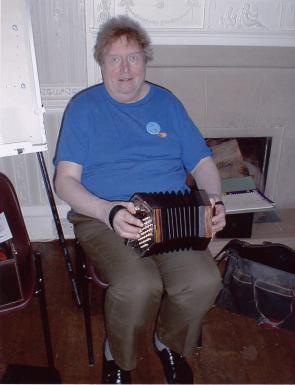 |
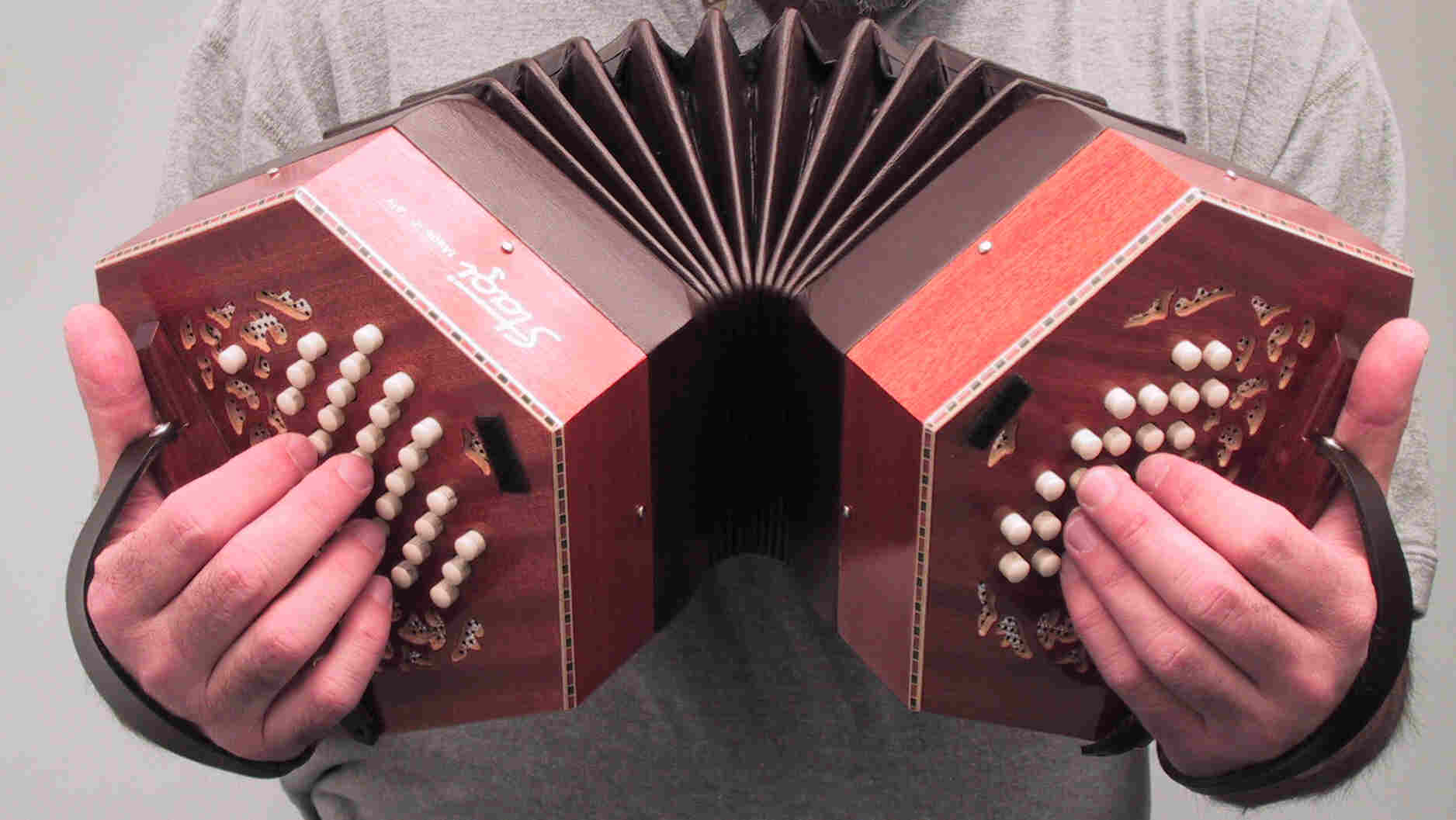 |
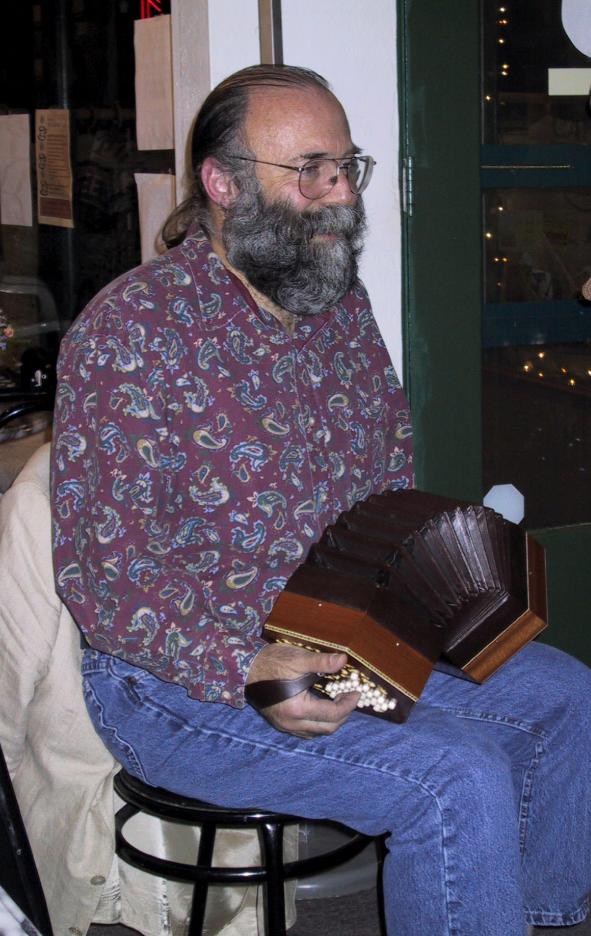 |
Musical inventor
Brian Hayden
playing the prototype
Marcus Music Hayden
Duet 65
at the Kilve weekend 22
March 2003
(image courtesy of
Marcus
Music ) |
Playing a Stagi
Hayden Duet 46 Concertina in "airborne" or "free air"
style.
The precise expansion shown I have come to feel is a
bit extreme for the bellows. Nowadays I draw the bellows
more moderately.
|
Jax
plays a Stagi 46-button Hayden system Duet
Concertina |
A Concertina is a free-reed instrument with valved reeds
and buttons controlling the valves mounted on the two sides of
the bellows. The player expands and contracts the bellows to
supply air to the reeds whose valves are open due to the player's
fingering the buttons. The buttons are mounted so that they face
outwards from the sides and are pressed towards the bellows.
How is a
Concertina different from an Accordion?
Concertina differs
from Accordion most simply in the orientation of the buttons.
- On an accordion, the right hand presses the keys or buttons
against the fingerboard which is oriented to the player's
chest.
- Concertina buttons are pressed inwards towards the
bellows, as are the buttons on the left-hand side of a
modern accordion.
- The traditional concertina has the reeds laid radially in
the reed pan, rather than mounted on a reed block like an
accordion.
- However,
- Many modern concertinas, especially Hayden duets,
have accordion-style reeds.
- Some modern concertinas have a reed plate on which
the reeds are mounted orthogonally and flat, unlike the
radial or reed block constructions.
- The fingering of most Accordion systems differs greatly
from the right side to the left side
- Whereas the two sides of a concertina are fingered very
similarly.
- Accordion tends to be heavier physically and musically
thicker and more powerful than concertina.
- Whereas concertina is delicate and expressive.
What is the Duet
Concertina?
Duet is a concertina fingering system. A
fingering system is a choice of notes and button positions
(and internally, the reeds associated with that choice) available
to the player on the instrument built according to the given
finger system.
Concertinas are generally in one of three fingering
systems:
- Anglo-Irish is designed for modal melody and simple
harmony.
- English is deisgned for chromatic melody.
-
Duet is designed for chromatic melody and complex
harmony. There are four major subsystems of Duet concertina:
As you can see, one of these systems, Duet, is itself
at least four contending fingering systems.
Note: there exist other concertina types, notably the
Chemnitzer and Bandonion/Bandoneon. For a fuller (if not
entirely complete) treatment of the types of concertina, please
see the excellent Squeezebox 101 by
Chemnitzer enthusiast extraordinaire Ted Kloba.
Here is a chart of the basic differences between the
major categories of concertina fingering systems:
Major Concertina
Fingering Systems
| Fingering System |
Tonality |
Sonorisation |
Balance |
Usual Buttons (Variant Buttons) |
Approximate Range of Most Common Variant |
| Anglo-Irish |
Diatonic |
bisonoric (different notes press/draw) |
bass left, treble right |
30 (20, 40, 48 ...) |
low C to third treble C |
| English |
Chromatic |
unisonoric (same note press/draw) |
scale steps alternate sides (C left, D right, E left
... etc.) |
48 (30, 40, 56, 60 ...) |
low G to third treble C |
| Duet |
Chromatic |
unisonoric (same note press/draw) |
bass left, treble right |
46 (56, 61, 67 ...) |
varies by sub-system |
That which characterizes and defines the Duet system is that
all its variants are:
- unisonoric (same note press/draw)
- chromatic
- bass-left, treble-right
What is Hayden Duet?
Hayden Duet is an attempt to
create a rational, modern fingering system for Duet. Previous
Duet systems deriving from the late nineteenth and early
twentieth century are somewhat difficult to learn and not
entirely effective for playing modern music.
The Hayden system was developed (and patented) by Brian
Hayden. Brian Hayden
was interviewed some years ago by Concertina.net and
also interviewed in 2003
by the author of the present web page . The Concertina.net
article has some great fingering system charts from various
Duet systems, including the 46-button Hayden and 67-button
Hayden. There are also PDF's of several
interesting Hayden Duet articles here on the Maccann Duet
Page.
As a longtime accordion player, I was attracted the Hayden as
the concertina fingering system most suited for modern music and
probably the easiest to learn for an accordion player. I have
since learned English and Anglo fingering also, which led me to
the following observations:
- While the English system is ideal for melody, many chord
changes are practically impossible to finger.
- Anglo is the fastest fingering system within its tonal
limitations but is not at all suited to richly chromatic
music.
- As a musician who performs a wide range of styles, from
classical through folk and ethnic to show tunes, pop and jazz,
I find myself committed to Hayden system.
Here are some links to images of Hayden system Duets by
various makers, from which you will discover that even with this
modern system there is a great deal of variety in actual
construction, due, in part, to the varying degrees of the
builders' ingenuity exerted in squeezing a large number of reeds
into a concertina and in part due to the natural evolution of
this relatively new (about 30 years old) but extraordinarily
powerful fingering system.
The range of the 46-button Hayden duet is low C to D above
second high C. The instrument is fully chromatic between low E
and its highest note. The sides overlap on middle C to B above
middle C except the left is missing the Bb in that octave (it's
present on the right, though). There are 21 keys on the left and
25 on the right; additionally, the Hayden has a bellows release
or "air button" (not shown) on the right hand towards the thumb
rest from the keys. In the chart below , notes ascend to
the right and upwards. Middle C on both sides in the diagram
below is noted as <C>.
46-key Hayden System
layout
| Left hand |
Right hand |
|
|
|
|
|
|
|
|
|
|
|
|
|
|
|
|
|
|
|
hi |
|
|
|
|
|
F |
|
G |
|
A |
|
B |
|
|
|
|
| Bb |
|
<C> |
|
D |
|
E |
|
F# |
|
G# |
|
|
F |
|
G |
|
A |
|
B |
|
C# |
|
D# |
|
|
C |
|
D |
|
E |
|
F# |
|
G# |
|
|
|
lo |
|
|
|
|
|
|
|
|
Thumb |
|
|
|
|
|
hi |
|
|
|
|
|
|
|
| Bb |
|
C |
|
D |
|
|
|
|
|
|
|
|
F |
|
G |
|
A |
|
B |
|
C# |
|
|
| Bb |
|
C |
|
D |
|
E |
|
F# |
|
G# |
|
|
F |
|
G |
|
A |
|
B |
|
C# |
|
D# |
|
|
<C> |
|
D |
|
E |
|
F# |
|
G# |
|
| Thumb |
|
lo |
|
|
|
|
|
|
|
|
|
|
An important part of the Hayden system is the spacing and
staggering of the columns of buttons. That spacing and staggering
is shown in the chart above, but not to scale.
What about larger Hayden
Duets?
When you play the 46-button Hayden, you get a light
but very rich tonal arrangment. You can play complex chords on
both sides. At first, I wondered if it could be asymmetrically
extended to add:
- a low C# and D# and a Bb above middle C on the left;
- a C# and D# above middle C on the right.
Note that rows advance left to right in whole steps. If you
start at the bottom of the left diagram, the first F# is one
half-step up from the F on the next row above it. The notes in a
row are ascending left right on both sides.
You might wish for some wraparound on each of the basic row
patterns, i.e:
Gb Ab Bb C D E F# G#
Db Eb F G A B C# D#
so that it would be easier to play the chords C#/Db
major, F#/Gb major, G#/Ab major and D#/Eb major. However, the
46-button Hayden Duet is already a good-sized instrument.
Bastari 67-Key Hayden
The 67-button Hayden Duet fingering system adds those
wraparound buttons and stretches the range downwards another
fourth. There are 33 buttons on the left and 34 buttons on the
right.This increase in the size and weight of the instrument must
be weighed and balanced against the value of the added buttons.
In the chart below , just as
in the previous chart,
the right-hand side has a bellows release which is not shown in
the chart, and middle C on both sides in the diagram below is
noted as <C> . Again, spacing and staggering of
the buttons is shown but is not to scale.
67-key Hayden layout
| Left hand |
Right hand |
|
|
|
|
|
|
|
|
|
|
hi |
|
|
|
|
|
|
Eb |
|
F |
|
G |
|
A |
|
B |
|
|
|
|
|
Ab |
|
Bb |
|
<C> |
|
D |
|
E |
|
F# |
|
G# |
|
| Db |
|
Eb |
|
F |
|
G |
|
A |
|
B |
|
C# |
|
D# |
|
Ab |
|
Bb |
|
C |
|
D |
|
E |
|
F# |
|
G# |
|
|
|
F# |
|
F |
|
G |
|
A |
|
B |
|
C# |
|
|
|
|
|
|
lo |
|
|
|
|
|
|
|
|
|
Thumb |
|
|
|
|
|
|
|
|
|
|
hi |
|
|
|
|
|
|
Ab |
|
Bb |
|
C |
|
D |
|
E |
|
|
|
|
|
| Db |
|
Eb |
|
F |
|
G |
|
A |
|
B |
|
C# |
|
D# |
|
Ab |
|
Bb |
|
C |
|
D |
|
E |
|
F# |
|
G# |
|
| Db |
|
Eb |
|
F |
|
G |
|
A |
|
B |
|
C# |
|
D# |
|
|
|
Bb |
|
<C> |
|
D |
|
E |
|
F# |
|
G# |
|
| Thumb |
|
|
lo |
|
|
|
|
|
|
|
|
|
|
|
|
Homewood Music 52-key
Hayden
Bob Tedrow of Homewood Music has designed and
built a 52-key Hayden
Duet corresponding to my suggested 55-key
system! In the images below provided by
Bob (Thanks, Bob!) you can see that:
- On the left-hand side
- the instrument goes from Low C to High C (second button
top row)
- includes the Middle Bb (first button top row) that is
so obtrusively missing on other Hayden designs
- includes the Low C# and Low D# on the partial row at
the bottom
- On the right-hand side
- the instrument goes from Middle C to Second High D
(third button top row)
- includes the Middle C# and Middle D# on the partial row
at the bottom
- as shown possesses no bellows release button, but Bob
subsequently added a bellows release on the right-hand side
which is now part of the design
Bob informs us that these instrument are custom built by
order and can include any of the options available on Homewood's
other concertinas as shown at http://hmi.homewood.net.
Homewood Music Hayden 52
Images
Left
hand
|
Right
hand
|
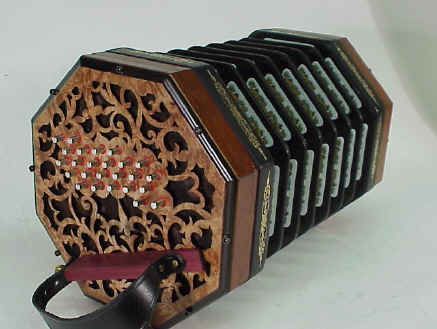
|
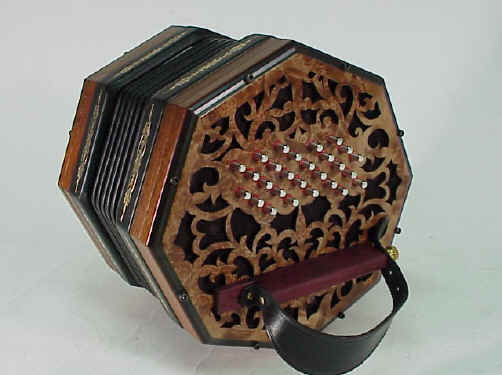
|
Brief review of
Homewood Hayden Duet
Recently (2004-11-12), the
shall-remain-anonymous concertina fancier who commissioned this
instrument and aided in its specification and design visited me
here here in Colorado and allowed me to play this fabulous
instrument. Unfortunately, both of us forgot our digital cameras
so I have no pictures of myself falling in love with the Homewood
Hayden Duet!
This attractive instrument is easy to play, light, barely heavier
than the Stagi, has plenty of volume and a full, balanced sound
which the anonymous fancier attributes to its Swiss reeds (in
preference to Italian reeds). The thumb rest is designed so that
Homewood can provide it in a range of orientations depending on
player preference. The bellows is excellent, supple yet firm.
The Homewood Hayden Duet is a masterpiece, a real winner.
Update
I recently visited
Homewood Music and played this instrument again (jamming with
Bob Tedrow on guitar!), which was in for some rework. I was more
impressed than ever with the instrument.
Marcus 65-key Hayden
In early 2003 Marcus Music arrives with
a new 65-key Hayden design ... Brian Hayden is pictured above playing
the prototype.
Here is the layout, provide courtesy of Marcus Music :
65-key Marcus Hayden
layout
Click on either image to see each of the two
layout charts at full size.
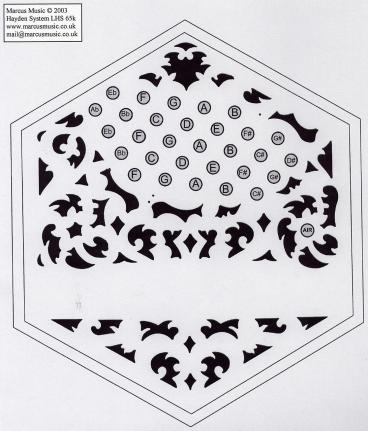 |
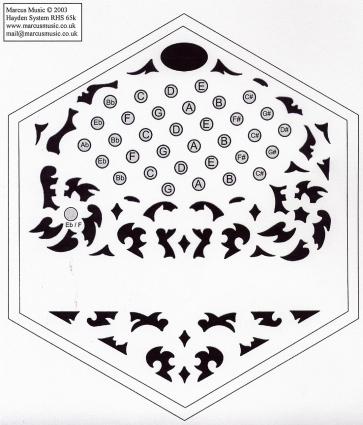 |
Marcus Hayden 65 left-hand side layout
Click on the image to see the layout chart at full
size. |
Marcus Hayden 65 right-hand side
layout
Click on the image to see the layout chart at full
size. |
Button Box 55-key Hayden
The 55-button Hayden Duet fingering system being developed by
The Button Box adds
wraparound buttons and stretches the range downwards another
fourth. There are 26 buttons on the left and 29 buttons on the
right. This is a tentative design and has not yet been finalized.
In the chart
below , the right-hand side has a bellows release which is
not shown in the chart, and middle C on both sides in the diagram
below is noted as <C>. Again, spacing and
staggering of the buttons is shown but is not to scale.
My current feeling about the design of any
prospective 55-button Hayden is that wrapound buttons like
the extra middle-Eb on the left hand in the chart below ,
and the extra high-Eb on the right side are less useful than the
missing 2nd-high-D# on the right hand, and the missing middle-C#
and middle-D# on the right hand, ibid . I have
instead proposed an alternative
interesting 55-key Hayden Duet Layout which may or may
not be practical to construct someday.
Thanks to Richard Morse of The Button Box for permission to
post this chart.
55-key Button
Box Tentative Layout
Left hand
|
Right hand
|
eb
|
|
f
|
|
g
|
|
a
|
|
b
|
|
|
|
|
|
Bb
|
|
<c>
|
|
d
|
|
e
|
|
f#
|
|
g#
|
|
Eb
|
|
F
|
|
G
|
|
A
|
|
B
|
|
C#
|
|
D#
|
|
bb
|
|
C
|
|
D
|
|
E
|
|
F#
|
|
G#
|
|
|
|
|
|
|
|
|
b
|
|
|
c#
|
|
|
|
|
bb
|
|
C
|
|
D
|
|
E
|
|
|
|
|
|
eb
|
|
f
|
|
g
|
|
a
|
|
b
|
|
C#
|
|
|
|
Bb
|
|
c
|
|
d
|
|
e
|
|
f#
|
|
g#
|
|
Eb
|
|
F
|
|
G
|
|
A
|
|
B
|
|
c#
|
|
d#
|
|
bb
|
|
<C>
|
|
D
|
|
E
|
|
F#
|
|
G#
|
|
|
Button Box Hayden
Update 2004-01-31
Here is Richard Morse's latest idea(s) for
two competing prospective layouts (minimal-small and optimal-big)
for the Button Box Hayden offering:
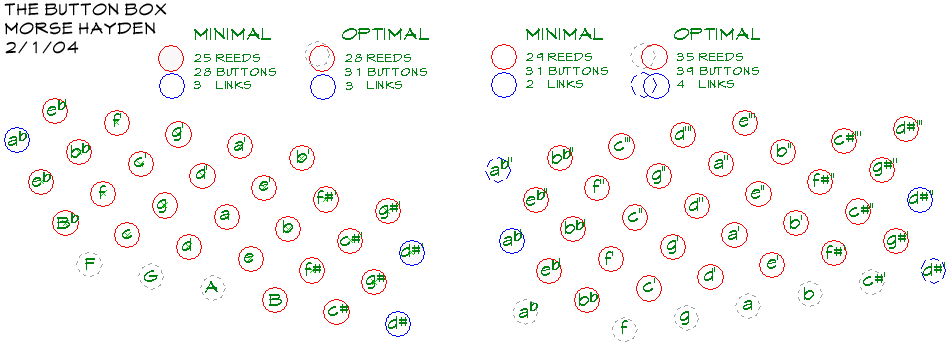
Used by permission of Richard Morse, thank you!
Haydenovskaya 64-key
Hayden
Samantha Boorer tells me about the Haydenovskaya
, a Russian Hayden by a master Bayan maker:
"The range is from F, G, and A then it gets chromatic but
there is no top Eb"', and is divided between left and right
like this:
- from F below viola C (i.e., the space below the bass
clef) to B above middle C in the left hand
- and from G below middle C (low G of the violin,
mandolin, etc.) to E almost 3 octaves higher."
From my own observation of photographs of the
Haydenovskaya, this is how its 64 buttons are apparently
arranged. In the chart
below , the bellows release (not shown) is again located on
the right towards the thumb rest from the keys. In the following
diagram, notes ascend to the right and upwards with middle C on
both sides being notated <C> . Again, spacing and
staggering of the buttons is shown but is not to scale.
64-key Haydenovskaya
layout
| Left hand |
Right hand |
|
|
|
|
|
|
|
|
|
|
|
|
|
|
|
|
|
|
|
|
|
|
|
hi |
|
|
|
|
|
Eb |
|
F |
|
G |
|
A |
|
B |
|
|
|
|
| Ab |
|
Bb |
|
<C> |
|
D |
|
E |
|
F# |
|
G# |
|
|
Eb |
|
F |
|
G |
|
A |
|
B |
|
C# |
|
D# |
|
|
Bb |
|
C |
|
D |
|
E |
|
F# |
|
G# |
|
|
|
|
F |
|
G |
|
A |
|
B |
|
C# |
|
|
|
|
|
lo |
|
|
|
|
|
|
|
|
|
Thumb |
|
|
|
|
|
|
|
|
|
hi |
|
|
|
|
|
|
|
Bb |
|
C |
|
D |
|
E |
|
|
|
|
|
|
Eb |
|
F |
|
G |
|
A |
|
B |
|
C# |
|
|
| Ab |
|
Bb |
|
C |
|
D |
|
E |
|
F# |
|
G# |
|
|
Eb |
|
F |
|
G |
|
A |
|
B |
|
C# |
|
D# |
|
|
Bb |
|
<C> |
|
D |
|
E |
|
F# |
|
G# |
|
|
|
|
|
|
G |
|
A |
|
B |
|
C# |
|
|
| Thumb |
|
|
|
|
lo |
|
|
|
|
|
|
|
|
|
Geuns Hayden/Wicki
Bandonion
Harry Geuns,
Belgian concertina/bandoneon maker, has provided the
following information about a proposed Hayden/Wicki
layout for a bandonion he is thinking of building, This
instrument is laid out in a version of the Hayden system we
have been describing here. Visit the
"Harry Geuns Free Reed
Maker" website for more information about this and his
other fine bandonions and concertinas. There are also
pictures of some
unusual
Harry Geuns bandonions on the
Jax RCFB Button Accordion
Page.
Geuns
proposed Hayden/Wicki Bandonion layout
Click on either image to
see larger.
|
Geuns proposed Hayden/Wicki Bandonion layout, left
side |
Geuns proposed Hayden/Wicki Bandonion layout, right
side |
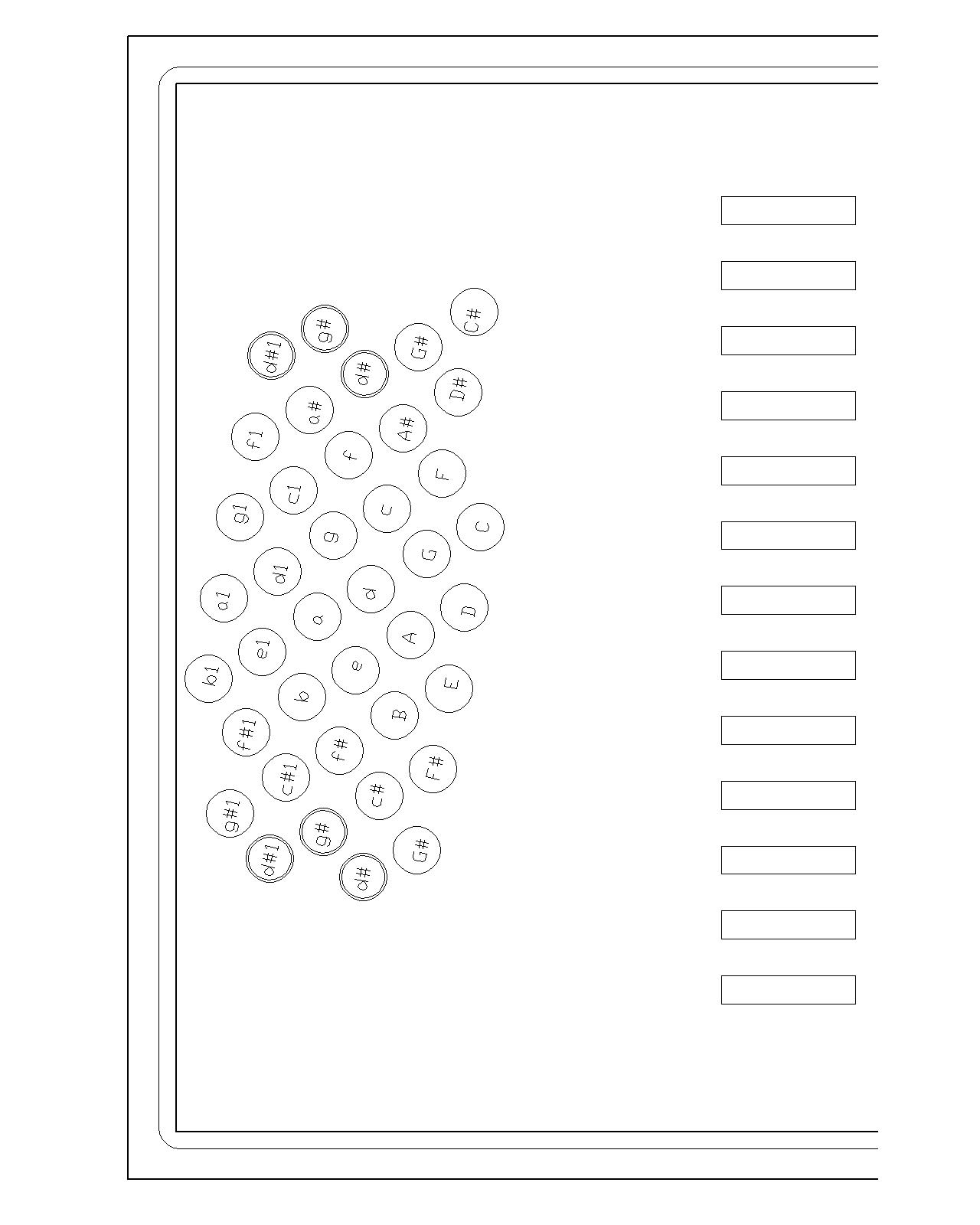
|
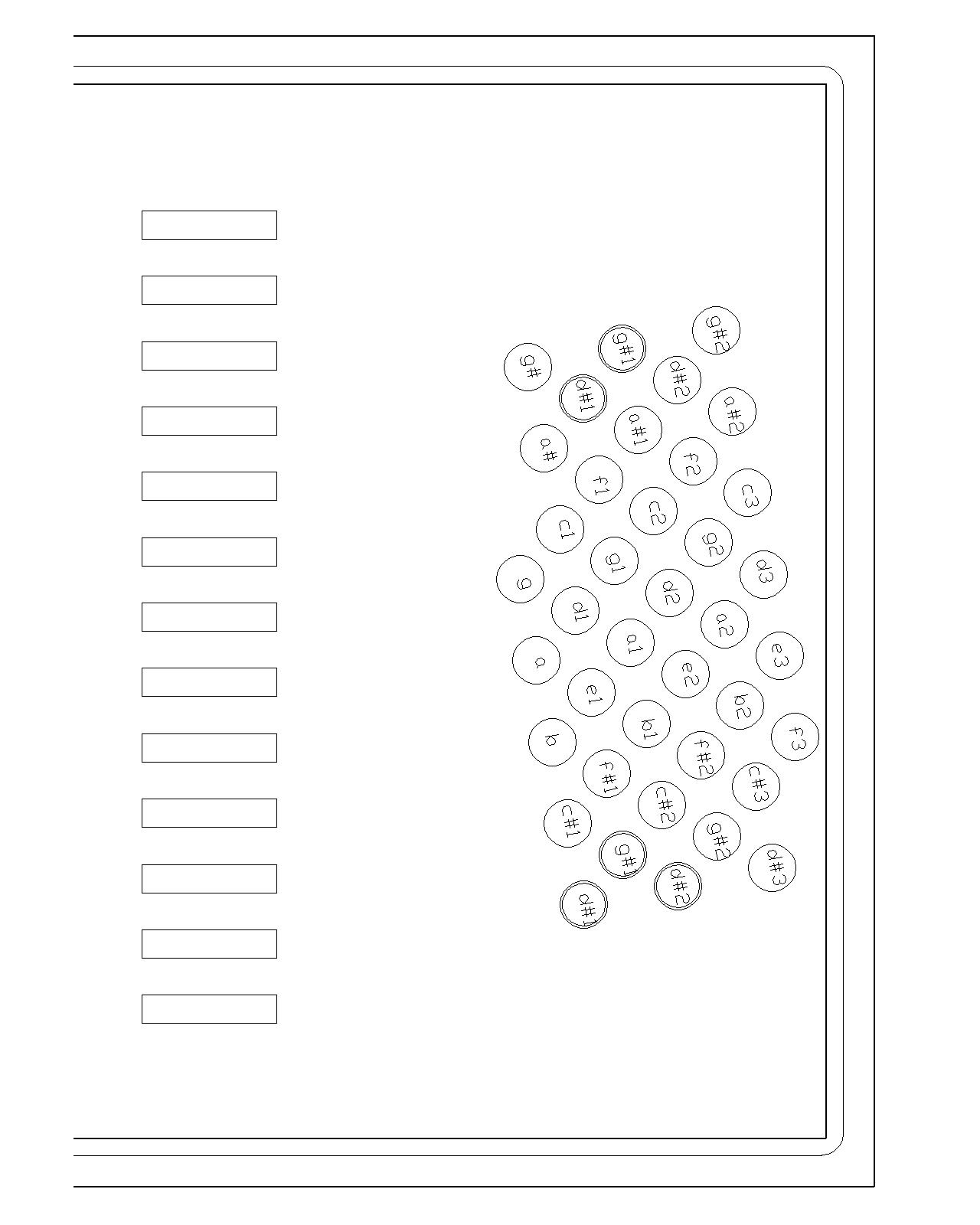
|
Why it called
"Hayden/Wicki"?
Harry Geuns writes:
The "Hayden" lay
out principle is originally patented in Switzerland in 1896
by Kaspar Wicki , as System Kaspar Wicki which again
is based on the "Janko" principle. Here is a
chart:
Wicki layout right
Click
on the image to see larger.
Wicki layout right
|
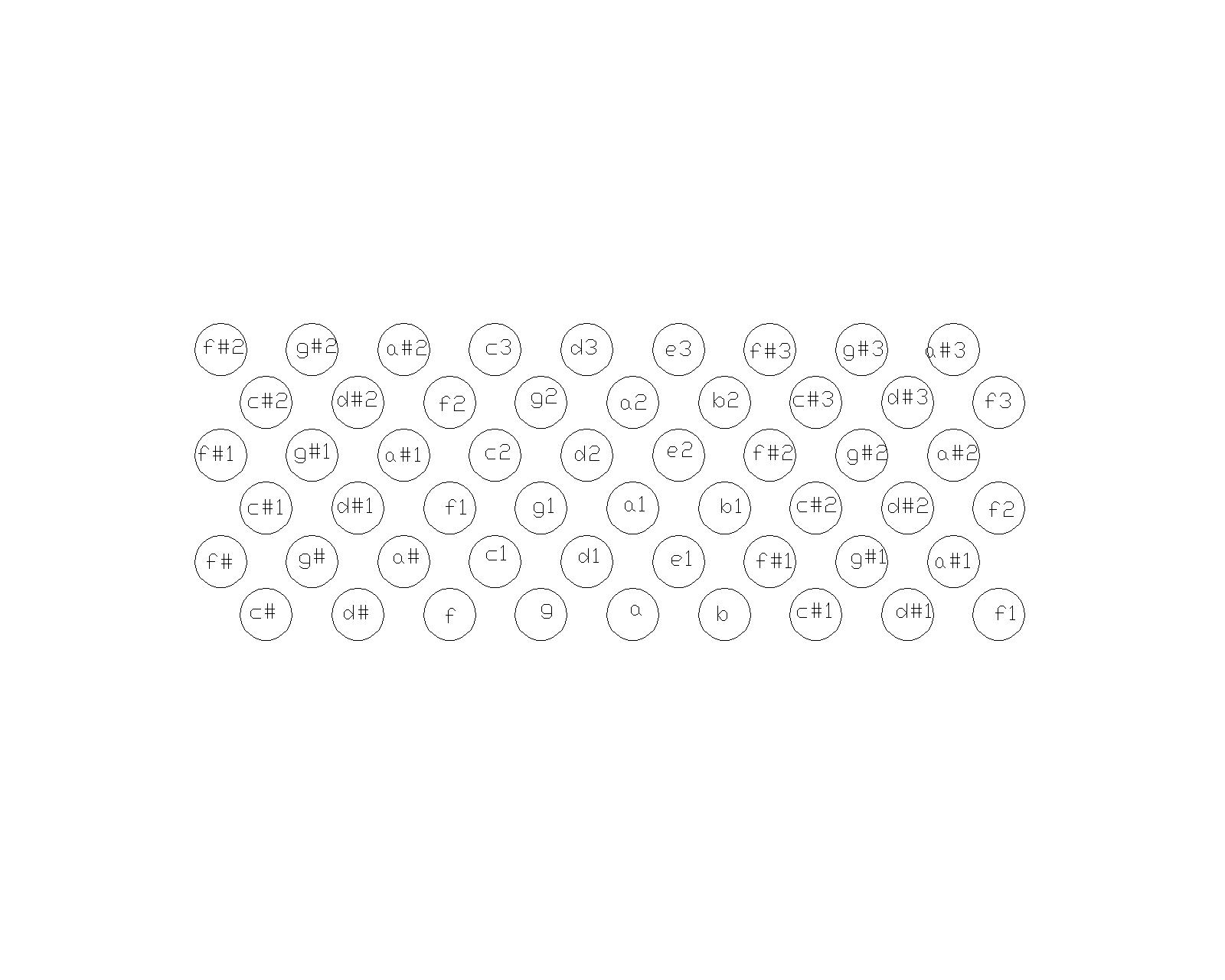 |
More Links of Interest
Table of Contents
 Rocky Coast Free Board
Rocky Coast Free Board
 Visit Jax Home Page
Visit Jax Home Page










